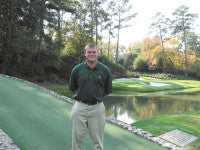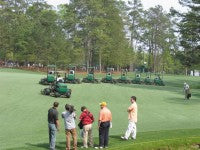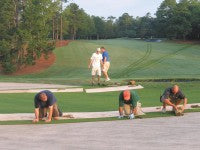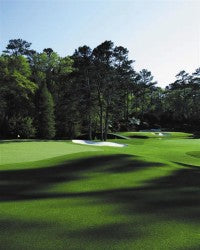Inside the ropes at Augusta National
 My first memory of Augusta National Golf Club was sitting in front of the TV with my dad, watching Ian Woosnam win The Masters in 1991. I had no idea what went into making that place look so perfect. But I do now, thanks to Mike O'Keeffe and The Ohio State University Programme. They got me in here for an experience of a lifetime.
My first memory of Augusta National Golf Club was sitting in front of the TV with my dad, watching Ian Woosnam win The Masters in 1991. I had no idea what went into making that place look so perfect. But I do now, thanks to Mike O'Keeffe and The Ohio State University Programme. They got me in here for an experience of a lifetime.
Jeff Foulger talks to Pitchcare about his placement at the home of The Masters.
My name is Jeff Foulger and I am a 26 year old greenkeeper from London. I started my career as an apprentice Greenkeeper in August 1997, at Chigwell Golf Club in Essex, under the supervision of Allan Sharp and Perry Lowe. I was taught a lot, learned a great deal and was generally guided in the right direction. During my time there I attended Warwickshire and Oaklands Colleges to achieve my qualifications.
Towards the end of my time at Chigwell, I decided that I wanted to further my knowledge and career. I sent my CV to, what I considered to be, the top dozen golf courses in Britain and was successful in getting a position at The Grove. I spent two and a half years there culminating in the preparation of the course for the World Golf Championship event. I also gained tournament experience at the K Club in Ireland working on the European Open to help better prepare myself for the WGC.
In my last year at the Grove I was already thinking about my next career move. I had often heard about training in America and all the benefits that could go with it. Everyone I talked to kept mentioning the Ohio State University Programme, either because they had experienced it themselves or had heard good things about it. This included Andrew Whittaker, a past student and Head Greenkeeper at the Grove. I decided it was time to get in contact with Programme Manager Michael O'Keeffe at the Ohio State University.
I sent him an in-depth CV with references. We spoke many times via email and on the phone. I felt that he really wanted to get to know me, my background and what I was all about. He told me about some of the success stories and the top quality placements that he had dealt with. Using his experience and knowledge he told me that he would select a placement that would best suit me.
So, when he mentioned Augusta National, my jaw nearly hit the ground! I had a couple of phone interviews and some forms to fill in. I can still remember trying to contain my excitement on the phone when the people at Augusta National Human Resources told me that I had been successful. All that was left was for me to obtain a J-1 visa and I was on my way.
The whole process probably took me two months from start to finish, but was well worth the effort.
I flew to Ohio to meet up with Mike and his team and very soon learned that the people at OSU were there to help and support me with absolutely anything.
When I arrived in Augusta I was, naturally, feeling rather nervous, but someone from Human Resources was waiting for me at the airport and soon calmed my fears. The staff and management were very friendly, welcoming and helpful.
My first day working at Augusta was on October 16th 2006.
From outside the gates there really is nothing to see but, once inside, it really is an amazing site. Through my first few weeks the management took a very patient and encouraging approach. I was shown how they like to do things and was involved in all the general maintenance tasks.
After a few weeks, I was scheduled to something called 'Greens Care'. This basically meant caring for allocated greens on a regular basis and setting them up before morning play began. This usually involved mowing the greens the amount of times requested by the Superintendent, raking greenside bunkers and anything else that I had time for, such as pitch mark repairs, dusting ball marks, picking poa annua, picking weeds out of bunkers, checking sand depths and switching or blowing debris away from surrounding areas.
I was scheduled to greens 6 and 14. This was my first task of the morning about three days out of seven. Other mornings consisted of pesticide applications or other general course set up procedures, such as mowing tees, moving holes and raking fairway bunkers.
After these first tasks were completed I was then assigned to something Augusta call 'Hole Care'. Basically, this involved being in charge of the day to day general maintenance of two holes. Obviously, the greens would have been taken care of under the 'Greens Care' system, but everything else was my responsibility. I ensured that all mowing was completed; pedestrian rotary, where the big second cut mowers couldn't get to, and hover mowers for pond and creek banks.
Once satisfied that these areas were in an acceptable condition I left to tackle whichever issues I think may benefit the holes. This could consist of many things, but it certainly encourages you to open up your eyes and work on attention to detail. If you can't find any problems or issues you can be assured that they will be found for you! But it is always nice to stay one step ahead of the game. Hole care was scheduled for the individual at least three days a week. I was scheduled to holes 11 and 12 and I considered this a great honour. I was very proud of my holes and was determined to do a good job.
Hole care was a big benefit to me and I learned a great deal, such as responsibility, scheduling and, when given extra manpower for a certain task, leadership skills. It's almost like being in charge of your own small golf course. When the 'Hole Care' tasks weren't assigned there were various other tasks to undertake.
Things pretty much stay the same throughout the autumn but, come the New Year, everything gears up for the Masters.
Tournament preparation
My tournament preparation generally consists of greens mowing and hole care duties. We get a lot more regular with morning and afternoon greens mowing, gradually lowering the height of cut and increasing the pace of the greens.
The hole care duties consist of regular mowing to create a real tight cut. We also look at resolving any small issues there may be on the holes. Because I have been working on my scheduled holes for so long I feel very protective towards them. This really makes me feel the importance of getting each hole as close to perfection as possible.
As time goes by the weather becomes warmer and drier and, to prevent any wilt appearing, we hand water our respective greens using 100 feet hoses keyed into the quick couplers. I ensure that I water every section of my 'Hole Care' holes to prevent any wilt. There is one person assigned to each of the 9 holes to set the greens for water in the mornings and afternoon, if and when needed.
Once all the grandstands are in place and the ropes put up, the course seems so much smaller and, somehow, easier to maintain. The flowers are beginning to bloom (the smell is amazing all round the course) and it has that real Masters feel about it.
I increase the attention to my assigned holes, tying up any small details. I don't like to use the word perfection but that's what we all strive towards.
Tournament week
The work schedule for the tournament is agreed in January, so we already know, a couple of months in advance, what we are going to be doing during tournament week. All the volunteers turn up on Sunday for a meeting and the crew becomes much bigger and better equipped. The extra machinery, supplied by Toro, is already in place and on standby. Monday and Tuesday are official practice days and are called Tournament Monday and Tournament Tuesday because they are treated exactly as if it were the first day of the tournament proper.

My morning consists of a very early morning meeting and, as soon as it is light enough, I am sent out for my scheduled greens run. For the tournament my greens were 1 and 6. I would go straight to the 1st green and mow it the amount of times it had been scheduled for that morning. If the committee are satisfied with the pace I move on to the 6th green and do exactly the same thing. Once all this has been completed all greens mowers meet up on the course, in an assigned area, and wait for the all clear to head back to base.
After the pre-play tasks are complete, I am sent out to my scheduled 'Green Care' hole, the 7th. I am on stand by to switch any sand splash or blow any debris off the putting surface using a small hand blower.
During the practice rounds, the place to be is on the par 3, 16th. After the pros have hit their tee shots, most of them then drop a ball in front of the water, which needs to be carried in order to reach the green, and attempt to skip the ball across the pond and on to the green, much to the excitement of the crowd; it gets very noisy down there.
On Wednesday the players play a tournament on the par 3 course. I was scheduled to a green and, with so many spectators on such a small piece of land, it makes for an electric atmosphere. It felt great to be so close to the action sitting right at the edge of the green. Most of the interest was focused on the Jack Nicklaus, Arnold Palmer and Gary Player group.
But my best experience is being at the back of the 7th green during tournament play, especially at the weekend watching the leaders come through. I then make my way back to base and carry on watching on the TV. My post golf task is afternoon greens mowing.
Once the final group has putted out on the 18th, the fairway mowers are given the green light to make a start. This is quite a sight. I counted fourteen fairway mowers all in a staggered row, with a mechanic following behind. Each operator has a tennis ball and, as well as monitoring their own operation, also monitor the operation of the machine in front. If any fault occurs with any of the machines, the tennis ball is thrown out ahead of the operator and all fairway mowers move around him. The mowers make their way around the course in one sweeping motion. It is the most photographed moment of the week.
The tournament was a great experience for me and the best week of my life to date. It surprised me just how much time and effort is put in to prepare the course and ensure that the high standards are maintained throughout the week. I was also impressed with the planning, organisation and control for such a big event. Once the tournament was over, I remember feeling proud and relieved that the event, that had turned into my life for the previous six weeks, had run so successfully and smoothly.
Post tournament
Once the tournament is over, the course is still open for at least another month. It is a challenge to restore the areas where the stands were and all the footfall areas.
The summer months give us a chance to do operations that we don't normally get the opportunity to do during the golfing season, i.e. renovation and construction. Also, a lot of spraying, topdressing, water management and sod work. These were the months that I took most out of, learning and experience wise. The tasks that occupied most of my summer was what they call 'Bent Set/Bent Check which is about water management on the greens. I would be scheduled to work ten days and then get four days off. During my ten days on, I would be scheduled, with another intern, to set the greens up with an adequate amount of hand watering.
There is a fine line that you learn to understand. Too much water increases the chance of disease activity - too little and it could burn up. Each green is treated differently and decisions are based on the weather forecast, how the green reacted on the previous days and how the green was looking in the morning. The greens are probed for soil moisture, taking into consideration that some greens have sub-air cooling systems and shade tents whilst others have fans to aid oxygenation. No work was required on greens 7, 9, 6 and hole 9 on the par 3 course as they were to be reconstructed in the summer.
The cut off point for watering greens is 9.00am. This is to prevent disease activity. Greens are checked in the afternoon. If any green starts to dry out and wilt it is lightly syringed to cool it down and help it through the day. Checking continues until the temperatures start to decline. This whole task requires a huge amount of dedication and it is a challenge to keep the greens in healthy condition.
The summer months here are very hot and, with high humidity levels, it can make for tough working conditions. In August, for three straight weeks, the temperature was over 100OF (37OC) every day.
Another factor that affects the greens is the aeration and topdressing programme during the summer. This is the only time of year that it can be carried out. The programme consists of three hollow coring operations followed by topdressing. The coring is at a different depth on each occasion with the lightest being the last one. We use a preventative fungicide programme which I was heavily involved in. I also keep a close eye on disease and insect activity. We have our own soil lab where I take samples, make a slide and look under the microscope to make an identification. There is also the equipment for a tissue test.
I am glad to say that the greens management this summer was a complete success. As mentioned previously four of the par 3 greens were slightly re-designed and sub-air cooling systems installed.
The fairways and second cut consist of rye and Bermuda grass. During the golf season the rye out competes the Bermuda but, if you look closely underneath, you can still see it. During the summer month s the Bermuda takes over and the rye dies off. Certain areas will be sodded with Bermuda. The Bermuda's purpose is to create a bed for the overseeding of rye grass. I use spray wetting agents as well.
s the Bermuda takes over and the rye dies off. Certain areas will be sodded with Bermuda. The Bermuda's purpose is to create a bed for the overseeding of rye grass. I use spray wetting agents as well.
Overseeding
The first process to prepare for the overseeding is to skin down/scalp all the Bermuda grass. This creates a bed for the rye seed. When this task is completed the tractors, with big sweepers attached, collect up all the clippings leaving the areas clear. The greens surrounds are mowed using pedestrian mowers with boxes on. A small team are employed purely to empty the boxes into a trailer. to speed up the process. Once all areas are mowed and clear, the overseeding commences.
The rye seed is applied via drop seeders trailed by tractors. Greens and tee complexes are seeded by pedestrian rotary spreaders. Pond and creek banks and other tight areas are seeded using pedestrian rotary spreaders. Once all the seed is laid the course is regularly watered using cycles on the irrigation system along with plenty of hand watering. This continues through germination and establishment. There is no driving on the course during this period; all the team use cart paths and pine beds.
Overseeding rates are 8 lbs/1000sq ft in second cut areas, 10lbs/1000sq ft on fairways, 14lb /1000 sq ft in landing areas and 20lbs/1000 sq ft on tees.
 With the course opening three weeks after overseeding, it gives us just enough time to mow out the course on a few occasions. We carry on with watering and pick up the attention to detail on hole care and get everything complete for opening and members opening party.
With the course opening three weeks after overseeding, it gives us just enough time to mow out the course on a few occasions. We carry on with watering and pick up the attention to detail on hole care and get everything complete for opening and members opening party.
Final Chapter
I would like to finish by saying that my eighteen months experience with the Augusta National really has been the complete internship. My training, under the supervision of Golf Course Superintendent, Brad Owen, and his assistants Matt Smith and Jim Evans, really has increased my knowledge of golf course management. I have been taught a lot about pesticide and fertiliser programmes, irrigation repair and maintenance, water management and machinery mechanics.
I would like to thank Brad and The Ohio State University Programme Manager, Mike O'Keeffe, for giving me this fantastic opportunity. I would certainly recommend this to anyone who is serious about this great profession. I believe it has been the making of me as a Greenkeeper and a person, and it could be for others. I know that as well as the Augusta National, Ohio State has the greatest placements in America. If you want to know more about the programme and how it works, contact Mike directly at okeeffe.1@osu.edu.
Mike treats everyone as an individual and tries to find the best placement. I did not know it at the time, but he truly found the best placement for me.
I would like to dedicate this article to my very loving and supportive family.
Editors note: Jeff Foulger returned home to England in April, after his second Masters. If anybody would like to speak to him about his experience or have any questions, email him at jeffreyfoulger@hotmail.co.uk.
